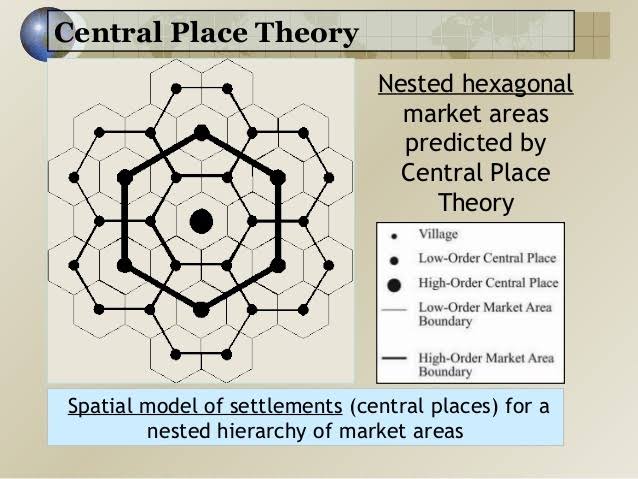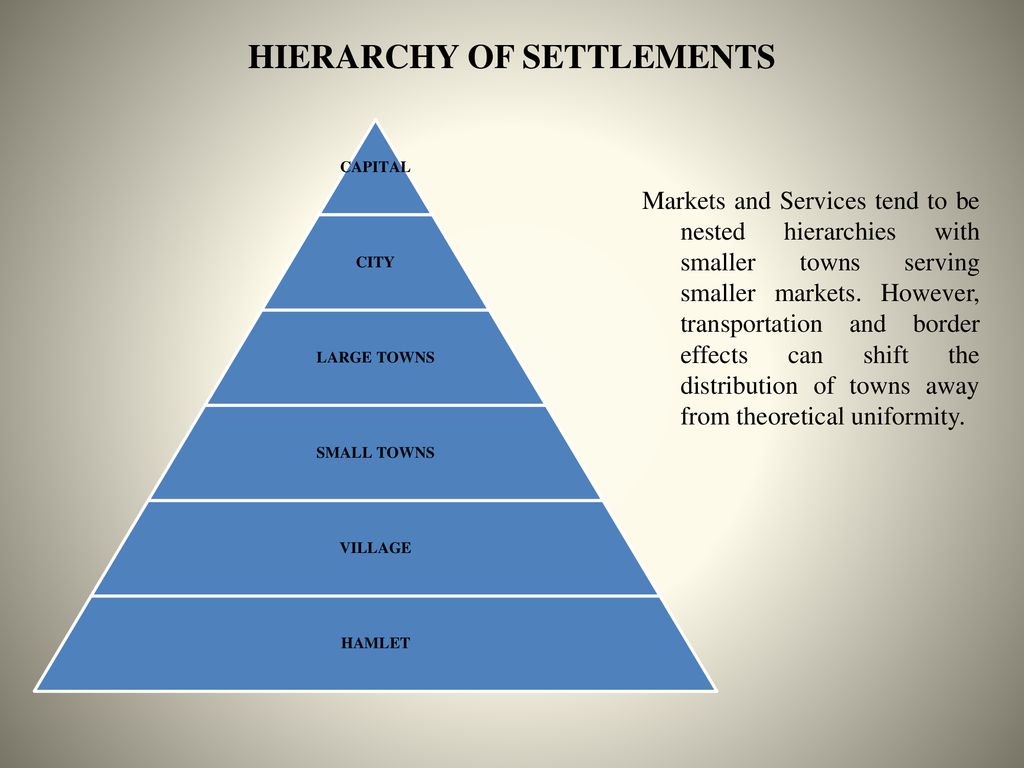Site Map Of Central place theory Central place theory Evaluation Strengths: Simplicity: Empirical Evidence: Practical Applications: Predictive Power: Limitations: Overgeneralization: Lack of Flexibility: Assumptions: Limited Scope: Central place building of theory Hexagonal Market Area: Hierarchy of Central Places: Transportation Costs: Market Area Threshold: Economy of Scale: Central place theory Predictions Hierarchy of Settlements: Market Area Threshold: Equal Distance Principle: Transportation Costs: Concentration of Economic Activity: Central place theory examples Urban Areas: Rural Areas: Developing Countries: Retail Location: Tourism: Central place theory criticism Simplistic Assumptions: Ignores Cultural and Historical Factors: Transportation Costs: Insufficient Explanation of Urbanization: Empirical Evidence: Making Central Place Theory operational Collect Data: Determine Market Areas: Apply Thresholds: Analyze Transportation Costs: Evaluate Predictions: Develop Models:
Central Place Theory is a geographic theory that explains the distribution of settlement patterns and the economic organization of a region.
The theory was developed by the German economist Walter Christaller in the 1930s and it explains the spatial organization of cities and their role in serving surrounding rural areas.
The theory is based on the idea that settlements are organized around a central place, which provides goods and services to surrounding areas.
According to the theory, central places are arranged in a hierarchy, with larger central places serving a wider area and providing a greater range of goods and services than smaller ones.
The theory also suggests that the distribution of central places is influenced by transportation costs and the availability of natural resources.
Central Place Theory has been used to analyze and understand the spatial organization of settlements in many different regions, including urban areas, rural areas, and developing countries.
It has been particularly useful in understanding the distribution of goods and services in regions, and the role of central places in supporting economic activities.
The theory has been modified and expanded over the years, but it remains an important tool for understanding the spatial organization of settlements and their economic relationships.
Central place theory Evaluation
Central Place Theory has received both support and criticism in its evaluation. Here are some strengths and limitations of the theory:
Strengths:
Simplicity:
Central Place Theory provides a simple and straightforward explanation of the distribution of settlements and their economic organization.
Empirical Evidence:
The theory has been supported by empirical evidence in many regions, including urban areas, rural areas, and developing countries.
Practical Applications:
Central Place Theory has practical applications in regional planning, urban development, and policy making.
Predictive Power:
The theory has predictive power, meaning that it can be used to make predictions about the distribution of settlements and their economic organization.
Limitations:
Overgeneralization:
The theory oversimplifies the complexity of settlement patterns and ignores other factors, such as cultural and historical influences, that may affect the distribution of settlements.
Lack of Flexibility:
Central Place Theory does not account for changes in transportation costs, technological innovations, and other factors that can affect the distribution of settlements.
Assumptions:
The theory relies on several assumptions that may not always be applicable in all regions. For example, the theory assumes that people will travel equal distances to obtain goods and services, which may not always be the case.
Limited Scope:
Central Place Theory primarily focuses on the economic organization of settlements, but ignores other important aspects of settlements, such as their social, cultural, and political organization.
Overall, Central Place Theory provides a useful framework for understanding the distribution of settlements and their economic organization. However, its limitations and oversimplifications must be taken into consideration when evaluating its applications and predictions.
Central place building of theory
Central Place Theory was developed by the German economist Walter Christaller in the 1930s. The theory was built upon several key assumptions and principles, which include:
Hexagonal Market Area:

Christaller assumed that the market area for each central place was hexagonal in shape and that the distance between each central place was equal. This assumption was based on the idea that people will travel equal distances to obtain goods and services.
Hierarchy of Central Places:

Image Source – SlidePlayer
The theory posits that central places are arranged in a hierarchy, with larger central places serving a wider area and providing a greater range of goods and services than smaller ones.
Transportation Costs:
The theory considers transportation costs to be an important factor in the distribution of settlements. Christaller assumed that transportation costs increase with distance, making it more expensive to transport goods and services over longer distances.
Market Area Threshold:
According to the theory, each central place has a threshold, which is the minimum number of people needed to support a certain level of goods and services. The threshold will vary based on the size of the central place and the range of goods and services provided.
Economy of Scale:
The theory also takes into account the concept of economy of scale, which states that the cost of producing goods and services decreases as the scale of production increases.
These assumptions and principles form the basis of Central Place Theory and provide a framework for understanding the distribution of settlements and their economic organization.
Christaller’s theory has been expanded and modified over the years, but it remains an important tool for understanding the spatial organization of settlements and their economic relationships.
Central place theory Predictions
Central Place Theory makes several predictions about the distribution of settlements and their economic organization. Some of the key predictions of the theory include:
Hierarchy of Settlements:
The theory predicts that settlements will be arranged in a hierarchy, with larger central places serving a wider area and providing a greater range of goods and services than smaller ones.
Market Area Threshold:
The theory predicts that each central place has a threshold, which is the minimum number of people needed to support a certain level of goods and services. This threshold will vary based on the size of the central place and the range of goods and services provided.
Equal Distance Principle:
The theory predicts that central places will be spaced equidistant from one another, based on the assumption that people will travel equal distances to obtain goods and services.
Transportation Costs:
The theory predicts that transportation costs will play a significant role in the distribution of settlements, with central places located near transportation hubs and along transportation routes.
Concentration of Economic Activity:
The theory predicts that economic activity will be concentrated in central places, with surrounding areas relying on these places for goods and services.
These predictions are based on the assumptions and principles of Central Place Theory and provide a framework for understanding the spatial organization of settlements and their economic relationships.
While the theory has been supported by empirical evidence in many regions, its predictions may not always hold true in all cases, as other factors, such as cultural and historical influences, may also play a role in the distribution of settlements.
Central place theory examples
Central Place Theory has been applied and tested in many regions and has been used to explain the distribution of settlements and their economic organization in different contexts. Here are some examples of how the theory has been used:
Urban Areas:
Central Place Theory has been used to explain the spatial organization of cities and their suburbs, with central cities serving as the primary central place for a wider region.
Rural Areas:
The theory has also been used to explain the distribution of settlements in rural areas, with larger central places providing goods and services for smaller surrounding settlements.
Developing Countries:
Central Place Theory has been applied to developing countries to explain the distribution of settlements and their economic organization in regions where transportation infrastructure is limited and transportation costs are high.
Retail Location:
The theory has been used to explain the location of retail businesses and shopping centers, with central places serving as the primary location for shopping and consumer goods.
Tourism:
The theory has been applied to the tourism industry, with central places serving as tourist destinations and providing a range of goods and services for tourists.
These are just a few examples of how Central Place Theory has been used to explain the distribution of settlements and their economic organization.
The theory provides a useful framework for understanding the spatial organization of settlements and their economic relationships, and has been applied in a variety of contexts and regions.
Central place theory criticism
Central Place Theory has been the subject of criticism and debate over the years, with some scholars pointing out limitations and drawbacks of the theory. Here are some of the main criticisms of the theory:
Simplistic Assumptions:
Some critics argue that the assumptions of the theory are too simplistic and do not reflect the complexities of real-world settlement patterns. For example, the hexagonal market area assumption does not always hold true in all regions, as settlements may not always be arranged in a regular pattern.
Ignores Cultural and Historical Factors:
The theory has been criticized for ignoring the role of cultural and historical factors in shaping settlement patterns. For example, the location of settlements may be influenced by cultural traditions, historical events, and political borders, which are not taken into account by the theory.
Transportation Costs:
Critics argue that the theory’s emphasis on transportation costs may not always hold true in all cases, as other factors, such as the availability of natural resources or the presence of political borders, may play a more significant role in shaping settlement patterns.
Insufficient Explanation of Urbanization:
Some critics argue that Central Place Theory does not provide a sufficient explanation for the process of urbanization, as it does not take into account the role of industrialization, migration, and other factors that have led to the growth of cities.
Empirical Evidence:
While the theory has been supported by empirical evidence in some regions, its predictions may not always hold true in all cases, and the validity of the theory has been challenged by some scholars.
These are some of the main criticisms of Central Place Theory, and while the theory has its limitations, it remains an important tool for understanding the distribution of settlements and their economic relationships. The theory continues to be modified and expanded, and its insights have been used to inform policy and planning decisions in many regions.
Making Central Place Theory operational
Making Central Place Theory operational involves putting its concepts and principles into practice to analyze and explain settlement patterns and economic organization. Here are some steps to operationalize Central Place Theory:
Collect Data:
The first step in making Central Place Theory operational is to collect data on settlement patterns and the distribution of goods and services. This data can be obtained through various sources, including census data, satellite imagery, and field surveys.
Determine Market Areas:
Once the data has been collected, the next step is to determine the market areas of each central place. This can be done by mapping the distribution of goods and services and calculating the threshold of each central place.
Apply Thresholds:
Thresholds can be calculated using a range of methods, including demand-based approaches, which take into account consumer demand for goods and services, and supply-based approaches, which take into account the costs of producing and distributing goods and services.
Analyze Transportation Costs:
The role of transportation costs in shaping settlement patterns can be analyzed by mapping transportation networks and calculating transportation costs, such as travel time and distance, between central places and their market areas.
Evaluate Predictions:
Once the market areas and transportation costs have been determined, the predictions of the theory can be evaluated by comparing the results to the patterns of settlement and economic organization in the region being studied.
Develop Models:
The insights from the analysis can be used to develop models that can be used to predict settlement patterns and economic organization in other regions or under different conditions.
These are some of the steps involved in making Central Place Theory operational. The theory provides a useful framework for understanding the distribution of settlements and their economic relationships, and its concepts and principles can be applied in a variety of contexts and regions to analyze and explain settlement patterns.

1 thought on “Central place theory”